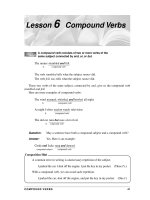State verbs and action verbs
Bạn đang xem bản rút gọn của tài liệu. Xem và tải ngay bản đầy đủ của tài liệu tại đây (10.57 KB, 1 trang )
State verbs and action verbs
In English, there are basically two kinds of verbs – action verbs and state verbs.
As the name itself suggests, action verbs indicate an action of some kind. Examples are: throw, catch, play,
come, work, sing, dance, write, cook and break.
State verbs refer to a state. Examples are: have, be, believe, know, love, hate, dislike, like etc. While have and be
show possession and existence, other state verbs describe ideas connected to our minds and thoughts.
State verbs are not normally used in the continuous form. For example, we don’t normally say: I am loving you.
We say: I love you. (You either love people or you don’t.)
Love is a state verb and it doesn’t usually have a continuous form. Note that the participle loving can be used as
an adjective. Example: loving parents
Continuous forms are usually used to describe temporary actions and situations that are going on at the
moment of speaking. State verbs, on the other hand, refer to more permanent situations and that probably
explains why they are not used in continuous forms.
I know Jane. (NOT I am knowing Jane. You either know people or you don’t.)
Some state verbs also have an action meaning. A good example is the verb ‘think’. When think refers to the act
of thinking, it can have a continuous form.
What are you thinking about?
I am thinking about writing a novel.
But when think means ‘have an opinion’, it does not have a continuous form.
What do you think of the weather in our country? (NOT What are you thinking of the weather in our
country?)
Stay on top of your writing! Download our grammar guide from www.englishgrammar.org to stay up-to-date.
Powered by TCPDF (www.tcpdf.org)









